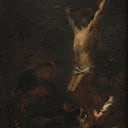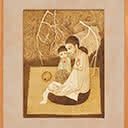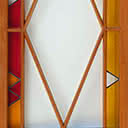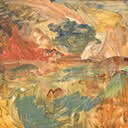Gillman House
267 x 81 cm
PROVENANCE
Private Collection, Auckland
LITERATURE
Bridget Hackshaw, The Architect and the Artists:
Hackshaw McCahon Dibble: The collaborative
projects 1963-1979, (Massey University
Press, Auckland) 2021
It is extremely rare, possibly even unprecedented, for a work in glass by Colin McCahon to come up for auction. There is a simple explanation for this. Such works were never made for sale on the open market. They were invariably commissioned, mostly by Roman Catholic churches or schools and in three cases by private citizens who wanted glass windows by McCahon in their houses. This beautiful window is one of these. It was commissioned for a house in Remuera by Dr John and Peggy Gillman in 1979. The Gillmans were friends of the architect James Hackshaw who was directly involved in all twelve of McCahon's glass commissions between 1965 when he engaged the artist to provide painted windows for the clerestory of the Convent Chapel of the Sisters of Our Lady of the Missions in Upland Road, Remuera and 1979 when he asked McCahon for a window for the Gillmans' house which he was renovating. This window was the last of McCahon's works in glass. The full story of McCahon's remarkable, if under-publicised activities as a glass artist in the last phase of his career, has been told in extensive and richly illustrated detail by the architect's daughter Bridget Hackshaw in The Architect and His Artists: Hackshaw McCahon Dibble (Massey University Press, 2021). However, although she writes about the Gillman window and illustrates it with a contemporary photograph, Hackshaw wrongly believed that the window had not survived the 1980s demolition of the house for which it was made. She wrote: The developer tried to find the vendor, but he was unsuccessful and it is believed that the window was destroyed (p. 221). But this was not the case. The window was preserved by the original owners and has now been brought to auction. In a letter to his Wellington dealer, Peter McLeavey, McCahon explained that he had worked on the commission for most of 1979. On December 2 he wrote: I'm still working on the Dr Gillman glass. At long last it's all installed and looks magnificent. It's really great with its great ¼ inch plate, clear bevelled diamond in the middle. The surrounding colour is superb... (quoted in Hackshaw, p. 222). Apparently the design of the window was somewhat changed when the company providing the steel framework for the glass went out of business, and the steel had to be replaced by a wooden armature. Such changes and tribulations are nowhere evident in the finished window which gives every impression of being superbly resolved and complete. Since most of McCahon's works in glass were for Catholic schools, chapels and churches, religious imagery predominates, including crosses, Christograms such as INRI, IHS and XP, plus the symbolic use of coloured glass. Even so, figurative and abstract imagery is also sometimes employed, as in the multiple hill shapes in a window of St Patrick's Church in Te Puke. In windows for private houses McCahon opted for secular imagery - a kauri tree in one, multiple landscapes in another, and pure geometric abstraction in a third (the Gillman window). McCahon had previously used a central diamond shape in a pair of corner windows for Baradene College in Remuera. In utilising this shape in combination with square and rectangular panels he was also consciously alluding to the windows of colonial Auckland villas - designs that he also referenced in a 1959 painting Landscape through a Victorian window (University of Auckland). McCahon also borrowed the shark-tooth pattern from Maori design in triangular inserts into the narrow edge-panels of the window. In terms of colour he surrounds the clear glass of the central shape with squares of blue and green, and rectangles of red and yellow - a superbly colourful and harmonious effect.
PETER SIMPSON





